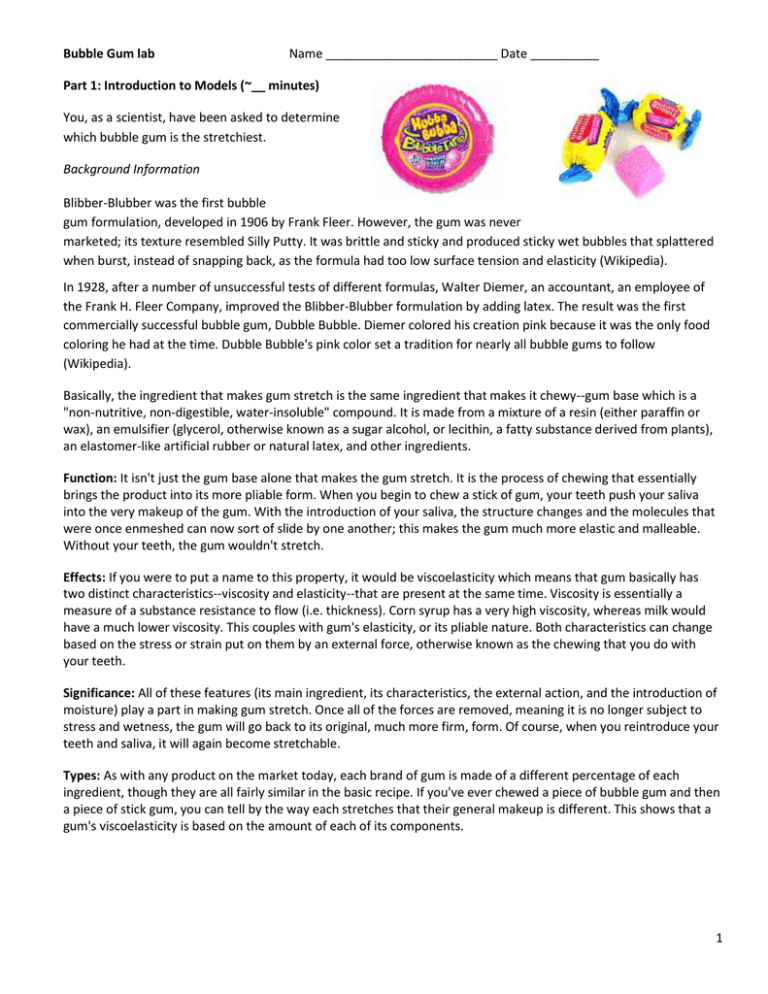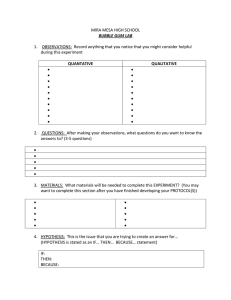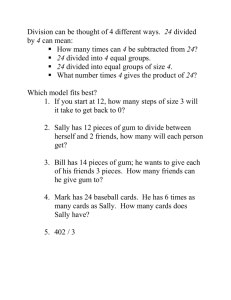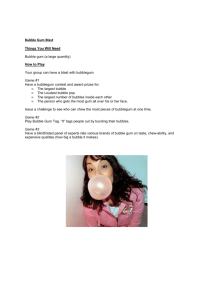Bubble gum lab
advertisement

Bubble Gum lab Name _________________________ Date __________ Part 1: Introduction to Models (~__ minutes) You, as a scientist, have been asked to determine which bubble gum is the stretchiest. Background Information Blibber-Blubber was the first bubble gum formulation, developed in 1906 by Frank Fleer. However, the gum was never marketed; its texture resembled Silly Putty. It was brittle and sticky and produced sticky wet bubbles that splattered when burst, instead of snapping back, as the formula had too low surface tension and elasticity (Wikipedia). In 1928, after a number of unsuccessful tests of different formulas, Walter Diemer, an accountant, an employee of the Frank H. Fleer Company, improved the Blibber-Blubber formulation by adding latex. The result was the first commercially successful bubble gum, Dubble Bubble. Diemer colored his creation pink because it was the only food coloring he had at the time. Dubble Bubble's pink color set a tradition for nearly all bubble gums to follow (Wikipedia). Basically, the ingredient that makes gum stretch is the same ingredient that makes it chewy--gum base which is a "non-nutritive, non-digestible, water-insoluble" compound. It is made from a mixture of a resin (either paraffin or wax), an emulsifier (glycerol, otherwise known as a sugar alcohol, or lecithin, a fatty substance derived from plants), an elastomer-like artificial rubber or natural latex, and other ingredients. Function: It isn't just the gum base alone that makes the gum stretch. It is the process of chewing that essentially brings the product into its more pliable form. When you begin to chew a stick of gum, your teeth push your saliva into the very makeup of the gum. With the introduction of your saliva, the structure changes and the molecules that were once enmeshed can now sort of slide by one another; this makes the gum much more elastic and malleable. Without your teeth, the gum wouldn't stretch. Effects: If you were to put a name to this property, it would be viscoelasticity which means that gum basically has two distinct characteristics--viscosity and elasticity--that are present at the same time. Viscosity is essentially a measure of a substance resistance to flow (i.e. thickness). Corn syrup has a very high viscosity, whereas milk would have a much lower viscosity. This couples with gum's elasticity, or its pliable nature. Both characteristics can change based on the stress or strain put on them by an external force, otherwise known as the chewing that you do with your teeth. Significance: All of these features (its main ingredient, its characteristics, the external action, and the introduction of moisture) play a part in making gum stretch. Once all of the forces are removed, meaning it is no longer subject to stress and wetness, the gum will go back to its original, much more firm, form. Of course, when you reintroduce your teeth and saliva, it will again become stretchable. Types: As with any product on the market today, each brand of gum is made of a different percentage of each ingredient, though they are all fairly similar in the basic recipe. If you've ever chewed a piece of bubble gum and then a piece of stick gum, you can tell by the way each stretches that their general makeup is different. This shows that a gum's viscoelasticity is based on the amount of each of its components. 1 Instructions 1. Read the Background Information and highlight important information as you read. 2. Write down everything that you think will affect the stretchiness of bubble gum. It can be a list, or in the form of a mind map/web/model Cognitive Apprenticeship What is the importance of a knowledge model when doing science research? • Provides a representation of a real world phenomena • Explains why things happen – explanatory • Can be tested - testable • Makes gaps in knowledge explicit - generative • Gaps in knowledge filled in through require evidence (through investigation) to expand - conjectural, revisable • clarify questions • identify important variables that can be measured Ingredients: Dubble Bubble has gum base + carnauba wax, sugars, flavorings, and food coloring. ____________________________________________________________________________ Part 2: Experimental Design (~__minutes) Instructions 1. With a partner discuss one factor from the model that you would like to test. 2. Based on the factor that your group chose, write a more specific research question. 3. What do we need to think about to write a good research question? a. It should come from the model b. It should be based on our scientific knowledge c. Scientists test ideas, not things d. Have your teacher approve your research question before moving on. 4. After your teacher has approved your research question, write the hypotheses in simple statements (NOT if…then). Hypotheses need to be specific and based on scientific knowledge. Have your teacher approve your hypotheses before going on. Null hypothesis: factor will not affect how far the gum stretches Alternative hypothesis 1: factor will increase stretchiness Alternative hypothesis 2: same factor will decrease stretchiness (n.b.: effect is the noun; affect is the verb) 5. Continue the experimental design by completing the following IN ORDER. IV: (be specific) experimental groups: (be specific) control group: (select one of the exp. groups as the control group) DV: (be specific) (what you are going to measure, how you will measure it, what units) Constants: (important constants - refer to your model) Get approval from your teacher. ____________________________________________________________________________ 2 Part 3: Data Collection / Data Analysis (~__minutes) Instructions 1. Construct a group raw data table in your lab notebook. Review the directions for doing this. 2. Perform the experiment and record the raw data for your group. In order to understand what the data mean, you must analyzed the raw data. The raw data is not included in the lab report, because you must analyze the data, not expect your readers to do that for themselves. 3. Record your group’s raw data in the Excel spreadsheet to get class data. 4. When all class data has been entered, determine the mean, median, and standard deviation (SD) for these data. 5. Create a class data table in your lab notebook. Review the directions for doing this. Include mean, median, and (SD). 6. In your lab notebook, explain why is it important to analyze the class data instead of just your group’s data? ____________________________________________________________________________ Part 4: Graphing (~__minutes) Instructions 1. 2. 3. 4. Determine the proper graph for these data. Review the directions for choosing a graph. Review the directions for what to include on a proper graph. Using graph paper, create a graph of the class data. In your lab notebook, describe the trends seen in the data as shown in the graph. Look at the central tendencies as well as the variation with groups. 5. Go back and revise your model if necessary. Scientists continuously revised their models as more information is learned. ____________________________________________________________________________ Part 5: Communicating the Results (~__minutes) In this part you will communicate your findings to your readers. You will lead them through the data analysis by making a claim, giving the evidence (descriptive statistics), and then accepting or rejecting the null hypothesis. Just present the results, don’t explain why yet. You will do that in the next section (Discussion). Instructions Review the directions for writing the results section. Pay attention to the order of the parts. 1. Make a claim: Write a statement that answers the research question. 2. Provide a table of the descriptive statistics (central tendency and spread of data) and a graph to show how the data answered the research question. 3. Summarize trends in the data. (Refer to central tendency and variation.) 4. What does the data (in the table & in the graph) show? in words. Highest and lowest? 5. Restate the null hypothesis. In order for this to not be just some random sentence, clearly state that this is the null hypothesis and use quotes around it. 6. State if the null hypothesis was accepted or rejected. State if the alternative hypothesis is supported or not supported. 7. Proof read to remove personal pronouns and contractions and to improve clarity. ____________________________________________________________________________ 3 Part 6: Writing the Discussion / Argumentation (~__ minutes) In this part you will explain the findings that you just reported in the results section. It’s important to explain the science behind the findings. Include all parts of the discussion: claim, warrants, backing, evidence, and possible counter arguments. Instructions 1. Make a claim o Restate the claim to focus the reader on the answer to the research question. 2. Explain the scientific concepts behind the claim (reason for results. WHY?) o State the scientific concepts that are generally accepted as true (warrants). Warrants are found in your background information. o Give more details that support the warrants (backing). o Give your evidence (data analysis) that supports the claim 3. Identify strengths and limitations of evidence: o State if any data that did not fit the claim. Explain the reason if known. o State if there were errors in data collection, either due to errors with the equipment or procedural errors. o Give alternative explanations that can also explain the data obtained (counter arguments or qualifications) 4. Revise your model as necessary. ___________________________________________________________________________ Part 7: Writing the Conclusions Section (~__ minutes) Instructions 1. In paragraph format, using past tense and passive voice, summarize the knowledge gained from this experiment in 1-3 sentences. ___________________________________________________________________________ Part 8: Reviewing the Research (~__ minutes) Review the findings and conclusions. Instructions 2. Review other lab reports from your class. Did they present the findings in an understandable way? 3. Did they use a claim, warrants, and evidence in their discussion? 4. Review your own lab report and make notes in your lab notebook to help you improve future lab reports. Cognitive Apprenticeship Scientists review the work of others to learn new information and to improve their own writing. 4



